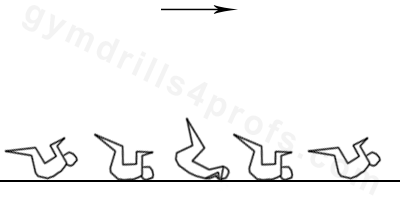


The backward roll is more difficult for the gymnast than the forward roll because the rotation is going backward, there can be a lot of pressure on the neck. Neck flexibility and proper placement of the hands against the floor are necessary for avoiding injury to the neck. Backward rolls are particularly difficult for very young gymnasts because of their body proportions. The proper starting position in gymnastics is to first stand up with the hands above the head. The gymnast lowers their body in a piked position and bends their legs into a squat stand. The head should be tucked to the chest, with the back rounded. The arms should remain above the shoulders. The gymnast should roll backward by dropping their buttocks to the floor and bringing their legs up over their head. Their hands should be placed on the floor, around the head. The pushing begins with the hands and arms when the tucked body is in vertical before the feet contact the floor. The rotation finishes in a squat stand, then the athlete stands up and raises their arms up above their head. Technically, the skill can start from a tucked stand, straddle, pike, or sit. Some common errors are rolling over one shoulder, a lack of push from the hands, an uneven push with the hands, failure to stand, and a lack of body control (loose). During the learning process, the coach might provide assistance, holding them by the hips, and pushing their back.

The gymnast should be laying back in a tucked position with a rounded back. The legs should be bent with the arms bent over the shoulders, next to the head. In this position, they should start rocking backward and forward.

The gymnast might sit on the mat or start the drill from standing. The inclined surface helps them to rotate easier, with a lesser push from the hands. Additionally, the mat is squishier than the floor, which can reduce some of the pressure that may be placed on the neck.

When the gymnast improves their body position during the rotation and they understand the proper push from their hands, they should perform the backward roll on a flat 4 or 8 inch mat. The benefit of this drill is that it’s still softer than the floor, but removes the incline of a cheese mat which helps the rotation.
Integral part of gymnastics coaching process are skill drills. They help gymnasts to learn easier and technically correct. With GYM DRILL PRO you will find variety of ideas for the most the basic gymnastics skills. There are plenty of images with skill drill progressions. It is intended to support explicitly the qualified coaches in their daily coaching business. DO NOT practice without the guidance of proper professionals.